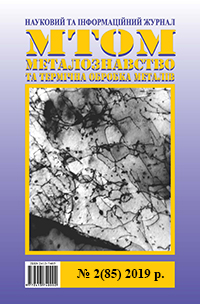Effective method of tin-free foundry bronzerefining from endogenous origin impurities
DOI:
https://doi.org/10.30838/J.PMHTM.2413.230419.544.294Keywords:
copper alloys, centrifugal casting, casting bronze, structural formation, phase composition, doping, X-ray spectral microscopy analysisAbstract
Problem statement. Ukraine in the ranking of leading suppliers of castings from copper alloys is among the top ten. In recent years there has been a rapid rise intheir production. This is due to expansion of demand for copper alloys not only in electrical engineering, but also in other areas of industry, in particular in automotive manufacturing of electric cars production. Purpose. Copper-aluminum-iron system alloys structure formation regularities analysis depending on amount of alloying components changing for technological recommendations development of a stable high level of mechanical properties of foundry bronzes obtaining in industrial production and operation. Material and Methods. Material of the study was casting bronze BrA9Zh3L according to GOST 493 requirements. Microstructure was investigated on metallographic specimens prepared according to standard methods as per ASTM E3-11. Analysis was performed using light microscopy on "Neophot-2" equipment. Scanning electron microscopy and X-ray spectral microanalysis were performed on Superprobe−733 equipment. Results. With the help of Cu, Al, Fe components binary and triple systems equilibrium diagrams studies results comparative analysis, X-ray spectral microscopy and local X-ray energy dispersion methods the controversial issue concerning iron-containing phase in BrA9Zh3L bronze structure origin has been solved. It has been found that this is β1phase, i.e. Fe3Al with dissolved copper atoms (up to 7,72 wt. %) and zinc in amount from 0,0 wt. % to 0,68 wt. %, depending on this component content in alloy. Centrifugal casting method effective technological parameters industrial testing have been discovered that itsdisadvantages associated with bundle of casting material liquation can be used in production as advantage for melt included endogenous origin impurities refining, in particular, iron-containing Fe3Al phase. Conclusions. Controversial issue concerning iron-containing phase in bronze BrA9Zh3L structure genesis has been solved. It has been established that this is a phase of endogenous origin β1, that is, Fe3Al. Centrifugal casting method effective technological parameters for the melt included endogenous origin impurities refining have been used in production.
References
Boguslaev V.O., Repyakh S.I., Mogilatenko V.G. and oth. Livarnіvlastivostі metalіv i splavіv dlya pretsizіynogo litva [Casting Properties of Metals and Alloys for Precision Casting].Zaporizhzhia : AT "MOTOR SICH", 2016,474 р. (in Ukrainian).
Gnatush V. Mirovoy ryinok litya 2012-2014: Itogi i prognozyi[World market of castings 2012-2014: Results and prognosis].Agentstvo Lityo++Publ. Retrieved from: http://on-v.com.ua/novosti/biznes/mirovoj-rynok-litya-2012-2014-itogi-i-prognozy/ (in Russian).
GOST 493-79 (1979). Bronzy bezolovyannyie liteynyie. Marki[Tin-free foundry bronzes. Grades] (in Russian).
Dvoynyie i mnogokomponentnyie sistemyi na osnove medi [Binary and multicomponent copper based systems]. Edited by S.V. Shuhardina. Moscow : Nauka Publ., 1979, 249 p. (in Russian).
Kurdyumov A.V., Pikunov M.V., Chursin V.M. and Bibikov E.L. Proizvodstvo otlivok iz splavov tsvetnyih metallov[Casting Production from Nonferrous Metals]. Moscow : Metallurgiya Publ., 1986, 416 p. (in Russian).
Leybenzon V.O., Pіlyushenko V.L., Kondratenko V.M.and oth. Tverdnennya metalіv i metalevih kompozitsiy[Solidification of Metals and Metallic Composites]. Kуiv : Naukova dumka Publ., 2009,446p. (in Ukrainian).
Lyakishev N.P. Diagrammyi sostoyaniya dvoynyih metallicheskih system : Spravochnik v 3-h tomah [Diagrams of double metallic systems state : Handbook in 3 Volumes]. Moscow : Mashinostroenie Publ.,1996–2000. (in Russian).
Maltsev M.V. Metallografiya promyishlennyih tsvetnyih metallov i splavov[Metallography of industrial non-ferrous metals and alloys]. Moscow : Metallurgiya Publ., 1970,364 p. (in Russian).
Savenkov Yu.D., Dubodelov V.I., Shpakovskiy V.A., Kozhanov V.A. and Shtepan E.V. Rafinirovannaya med Ukrainyi[Refined Ukrainian Copper]. Donetsk : Izd-vo DonNTU, 2008,176 p. (in Russian).
Smiryagin A.P., Smiryagina N.A. and Belova A.V. Promyishlennyie tsvetnyie metallyi i splavyi[Industrial non-ferrous metals and alloys]. Moscow : Metallurgiya Publ.,1974, 364 p. (in Russian).
Elektromobili protiv avto s DVS –itogi 2016 i perspektivyi 2017[Electrical Cars against Auto with ICE –Results of 2016 and 2017 Perspectives]. EkoTehnika [EcoTechnic]. Retrieved from: https:// ecotechnica.com.ua/stati/1921-elektromobili-protiv-avto-sdvs-itogi-2016-i-perspektivy-2017.html (in Russian).
ASM Metals Handbook. Volume 03: Alloy Phase Diagrams (2016) / ASM International. Retrievedfrom:https://www.asminternational.org/documents/10192/1849770/05442G_TOC.pdf/ecbf0e0e-cbe5-4d00-a82e-edc48bc156a4.
ASTM E3 – 11 (2017) Standard Guide for Preparation of Metallographic Specimens. Retrieved from:https://www.astm.org/Standards/E3.htm.
Uzlov K., Repiakh S., Mazorchuk V., Dziubina A. (2018). Phase Composition, Structure and Mechanical Properties of Industrial Bronze BrA9Zh3L Additionally Doped with Zinc. Scientific development and achievements: Monograph [Text]. LP22772, 20-22 Wenlock Road, London, N1 7GU, Vol. 5, Pp. 349−364. Retrieved from: https://www.google.com/search?q =Uzlov+K.%2C+Repiakh+S.%2C+Mazorchuk+V.%2C+Dziubina+A.+(2018).+Phase+Composition%2C+Structure+and+Mechanical+Properties+of+Industrial+Bronze+BrA9Zh3L+Additionally+Doped+with+Zinc.+Scientific+development+and+achievements%3A+Monograph&oq=Uzlov+K.%2C+Repiakh+S.%2C+Mazorchuk+V.%2C+Dziubina+A.+(2018).+Phase+Composition%2C+Structure+and+Mechanical+Properties+of+Industrial+Bronze+BrA9Zh3L+Additionally+Doped+with+Zinc.+Scientific+development+and+achievements%3A+Monograph&aqs=chrome..69i57.6182j0j8&sourceid=chrome&ie=UTF-8(in Russian).
Downloads
Published
Issue
Section
License
Authors that are published in this journal agree to follow the conditions:
Authors reserve the right to the authorship of his work and cede the right to the journal of first publication of this work on conditions of the license under the Creative Commons Attribution License, which allows others to distribute it freely with the obligatory reference to the author of the original work and the first publication of the work in this journal.

